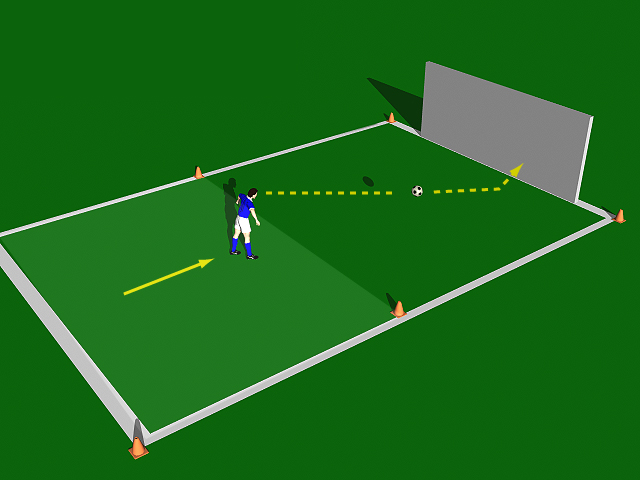Heading at Goal
| Although, at it's best, soccer is played mainly on the ground, the technique of heading the ball is vital. In the attacking third of the field it becomes harder to find space for passing the ball on the ground because of the number of defenders. Therefore, high balls are undoubtedly going to be played into the penalty area on many occasions. Each player should strive to develop his or her aerial ability when heading at goal. |
 |
| Practice |
| From the "base-line" and in between the two cones, hold the ball in your hands and head the ball out of your hands down towards the goal. After an adequate standard has been obtained, vary the practice by now throwing the ball into the air and slightly in front of you. As the ball is coming down, attack the ball and head the ball down towards the goal. Be alert for all rebounds and control them with your feet before picking up the ball with your hands. Be aggressive and determined to score each time. |
| What You Need to Know |
-
 In attacking heading the timing of the run by the player is of paramount importance. The player should try
to time the run so that he meets the flight of the ball as he is attacking the goal. The player should not
have to break stride.
In attacking heading the timing of the run by the player is of paramount importance. The player should try
to time the run so that he meets the flight of the ball as he is attacking the goal. The player should not
have to break stride.
 If the player makes a run to the ball too early, it will often lead to the player heading the ball from a static position, and very often marked by a defender. If the run is too late, the opportunity will undoubtedly be missed.
If the player makes a run to the ball too early, it will often lead to the player heading the ball from a static position, and very often marked by a defender. If the run is too late, the opportunity will undoubtedly be missed.
-
 The player’s eyes should be fixed on the flight of the ball.
The player’s eyes should be fixed on the flight of the ball.
-
 Contact is made with the center of the forehead. As the forehead is the hardest and flattest part of the
skull, it will lend to a more powerful and accurate header.
Contact is made with the center of the forehead. As the forehead is the hardest and flattest part of the
skull, it will lend to a more powerful and accurate header.
-
 Contact on the ball should be made through the center and above the horizontal mid-line of the ball.
This will direct the ball downwards.
Contact on the ball should be made through the center and above the horizontal mid-line of the ball.
This will direct the ball downwards.
-
 The run must be late, fast and aggressive.
The run must be late, fast and aggressive.
-
 On the approach to the ball, the player must slightly arch the back and tighten the neck muscles.
On the approach to the ball, the player must slightly arch the back and tighten the neck muscles.
-
 Immediately on making contact with the ball, the player should quickly swing the upper body and make contact on the ball with the center of the forehead. Further power can be achieved by pulling the arms
back when making contact with the ball.
Immediately on making contact with the ball, the player should quickly swing the upper body and make contact on the ball with the center of the forehead. Further power can be achieved by pulling the arms
back when making contact with the ball.
-
 When heading for goal, the ball should be headed down towards the goal line.
When heading for goal, the ball should be headed down towards the goal line.
